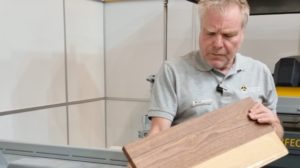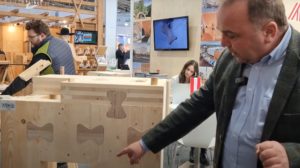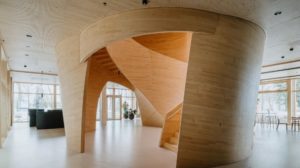It is interesting that some materials used a lot in furniture production have appeared by chance and by accident. That's how I came up with the article below.
MDF is a material widely used in the furniture industry whose finish I have written about repeatedly. It is a convenient material for manufacturers, which simplifies the production process, eliminating many of the problems created by solid wood. Another advantage is that, properly processed and finished, it can give the impression that the furniture is made from solid wood.
A simple mistake resulted in a material now highly prized in the furniture industry
This time I intend to present its history. Perhaps it would be interesting to know how and when it came about.
MDF - Medium Density Fiberdoard - was first developed in 1966 in the USA and is based on a 1925 invention by William Masson, made by chance, a technological accident, shall we say. He collected wood scraps and wood dust from local wood-burning stoves and mixed them with hot water in a plant to make a cheap insulator that was accessible to everyone. One evening, he forgot to turn the machine off and it continued working until morning. What resulted was a very thin and strong film, virtually the first version of PFL.
By 1974, MDF was already being mass-produced in Medford, Oregon (USA), and in 1976 the first exports to Europe, to the UK and the Netherlands, were made in 1976. In 1980, as production expanded, a factory was opened in Ireland. From this moment on, a strong development of the board production started, as well as its diversification with moisture resistant, colored, fire retardant, etc.
PAF, the Romanian version of pre-1989 MDF
In Romania, large MDF factories appeared after 1989. But even before that there were, in some CPLs (Combined Wood Processing Plants, for the younger generation), PAF (wood chip and fiberboard) factories, which is the name of MDF in Romania. The biggest factory, at that time, was in Focșani, but there were smaller plants in many other combined.
I remember something from those days. I was working at ICPIL (the Wood Industry Research and Design Institute) where much of our research consisted of copying what others were inventing abroad. Sometimes we wondered how we could figure them out from a blurry photo from a fair or a tiny sample.
One year, together with other colleagues, we had as a theme the realization of a piece of furniture in PAF, which we had to finish as attractive as possible and present it as an alternative to solid wood furniture. The theme was in collaboration with CPL Iași, which had a small plant for obtaining PAF. The boards were obtained and a table was made with a very interesting, elaborate design, just to demonstrate how many advantages this product has. Less consideration was given to the type of wood used for the boards. In fact, that was the whole idea - to use waste, offcuts, everything that was no longer used in production. The table was not very big, but so heavy that it was impossible to lift. That table was mounted in the factory showroom and I don't think it was ever moved from there, at least not assembled.
I hope you find the information interesting. As always, additions are welcome. And if you have any questions or queries, please leave them below in the dedicated space. I will be sure to reply.

































[...] MDF can also be finished modernly, in different colours, plain or combined. It is an attractive material, easy to finish and dimensionally stable. It also needs to be finished with materials that are resistant to kitchen conditions. [...]
[...] wood always, at that time, for economic reasons, I chose to make the doors (fronts) out of MDF and the casing out of chipboard. I live in an old house and the kitchen space is shaped [...]
[...] wood as a building material. So the project was made entirely of 18mm MDF, respectively 12mm for [...]
Interesting. I learn new things, presented in a pleasant way. Thank you!
And we thank you for your appreciation!